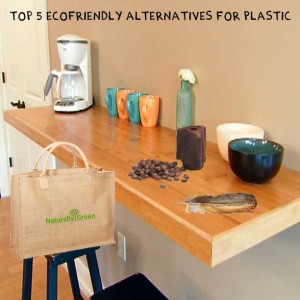Top 5 Ecofriendly Alternatives for Plastic
Top 5 Ecofriendly Alternatives for Plastic
Plastic is so ingrained in our daily lives that it is difficult to imagine without them. They are everywhere. They are durable, long lasting and have become a seemingly ubiquitous part of our national culture.
There is couple of ecofriendly alternatives to plastics. Here are some most common alternatives. 
Glass: We are so much used to plastic water bottles and milk bottles on our kitchen counters. Unlike plastic, glass is made from sand. This renewable source contains no chemicals that can leach into your food or body. And it's easily recycled. Sure, glass is a breakable material but it won't leech harmful chemical into your food when heated.
Reusable Shopping Bags: It is estimated that thousands of seabirds and mammals die each year by ingesting or choking on the discarded plastic bags. Burlap tote bags and jute bags are reusable grocery bags that can be used for years. Instead of hassling with weak and broken plastic bags, these reusable grocery bags are both strong and durable. Jute is one of the most versatile, durable natural fibers that are extremely sturdy, strong and has the life expectancy of over a thousand plastic carrier bags. When discarded, jute totally decomposes giving back all its valuable nutrients into the soil. These totes can easily withstand the heavy weight of groceries without breaking.Ecofriendly totes can be best used in retails. The retailer can sale them for free or put them on sale at a very minimal cost. This offer not only save the environment, but also reduces the cost associated with the usage of paper or plastic bags for the customers. The reusable grocery bags and jute bags come in a wide variety of sizes, styles and colors. Make a fashion statement with hot pink, lime green, orange or go neutral with a natural color. Choose from different styles, including drawstring, messenger, sport, beach and tote. CarryGreen offers large jute and cotton shopping bags which are the perfect size for veggies, bread, milk and other staples from the grocery store.
Chicken Feathers: Chicken feathers contain keratin, a protein so tough that it can make plastic durable and strong. Chicken feathers are inexpensive and abundant and they are a renewable source. Chicken-feather plastic is expected to be fully biodegradable. More than 3 billion pounds of chicken feathers are disposed annually in the states. (Source: Science Daily). But this disposing won’t be a problem since scientists have invented ecofriendly plastic made with chicken feathers.
Liquid Wood: Liquid wood, a bio plastic are exactly a replica for petroleum based plastic. The only difference with regular plastic is that they are completely biodegradable. This biodegradable form of plastic originates from pulp-based lignin which is a renewable source. They are made with woods. So they are 100% recyclable.
PLA Polyesters: Scientists are researching on how to make plastics from processed corn. Polylactic acid, or PLA most often is derived from corn, but PLA can be made from wheat, tapioca root and sugarcane also. PLA has the second highest consumption volume of bio plastic in the world.
